 Music
Music  Music
Music  History
History 10 Less Than Jolly Events That Occurred on December 25
 Weird Stuff
Weird Stuff 10 Funny Ways That Researchers Overthink Christmas
 Politics
Politics 10 Political Scandals That Sent Crowds Into the Streets
 Weird Stuff
Weird Stuff Ten Bizarre Facts About The Doge Meme
 Our World
Our World 10 Ways Your Christmas Tree Is More Lit Than You Think
 Movies and TV
Movies and TV The 10 Coolest Stars to Set Sail on The Love Boat
 History
History 10 Things You Didn’t Know About the American National Anthem
 Technology
Technology Top 10 Everyday Tech Buzzwords That Hide a Darker Past
 Humans
Humans 10 Everyday Human Behaviors That Are Actually Survival Instincts
 Music
Music 10 Surprising Origin Stories of Your Favorite Holiday Songs
 History
History 10 Less Than Jolly Events That Occurred on December 25
 Weird Stuff
Weird Stuff 10 Funny Ways That Researchers Overthink Christmas
Who's Behind Listverse?

Jamie Frater
Head Editor
Jamie founded Listverse due to an insatiable desire to share fascinating, obscure, and bizarre facts. He has been a guest speaker on numerous national radio and television stations and is a five time published author.
More About Us Politics
Politics 10 Political Scandals That Sent Crowds Into the Streets
 Weird Stuff
Weird Stuff Ten Bizarre Facts About The Doge Meme
 Our World
Our World 10 Ways Your Christmas Tree Is More Lit Than You Think
 Movies and TV
Movies and TV The 10 Coolest Stars to Set Sail on The Love Boat
 History
History 10 Things You Didn’t Know About the American National Anthem
 Technology
Technology Top 10 Everyday Tech Buzzwords That Hide a Darker Past
 Humans
Humans 10 Everyday Human Behaviors That Are Actually Survival Instincts
10 Strange Beauty Secrets Of History’s Most Beautiful Women
Being pretty isn’t easy. The most beautiful women in history weren’t just born that way. They put hard work into it—and, sometimes, a few crushed bug guts, stewed birds, or dung.
It’s the dirty little secret behind glamour: No matter how fantastic someone looks, it never comes naturally. Behind every great beauty in history, there’s a dirty secret about all the work that went into looking that good.
10 Empress Elisabeth: A Face Mask Lined With Raw Veal
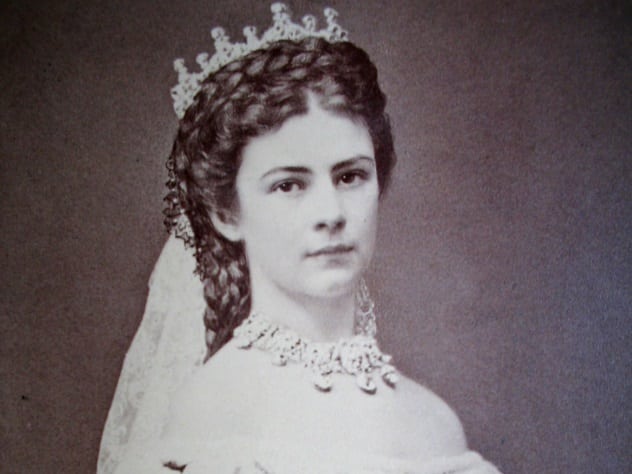
The most beautiful woman on earth, in the 19th century, was Empress Elisabeth of Austria. She was famous across Europe for her impeccable skin and the thick, chestnut hair that fell all the way down to her feet.
None of which came easy. To keep her skin beautiful, she would crush strawberries over her hands, face, and neck, bathe in warm olive oil, and sleep in what has only been described as a “mask lined inside with raw veal.”[1]
It was the closest she came to eating food. Her favorite dish was pressed extract of chicken, partridge, venison, and beef—which isn’t so much a “food” as something you’d find in a spice cabinet. And even then, she’d wrap herself in a corset so tight that her waist only measured 49.5 centimeters (19.5 in) around.
She spent three hours each day getting her hair down, mainly because it was so long that it would get tied up in knots. And when it was put up in ribbons, her hair would get so heavy that it would give her headaches.
It meant that, more often than not, she was stuck indoors, too afraid to let the wind ruin her hair. But if you want to be beautiful, sometimes you have to give up on little luxuries, like ever leaving your house.
9 Cleopatra: Bathing In Donkey Milk
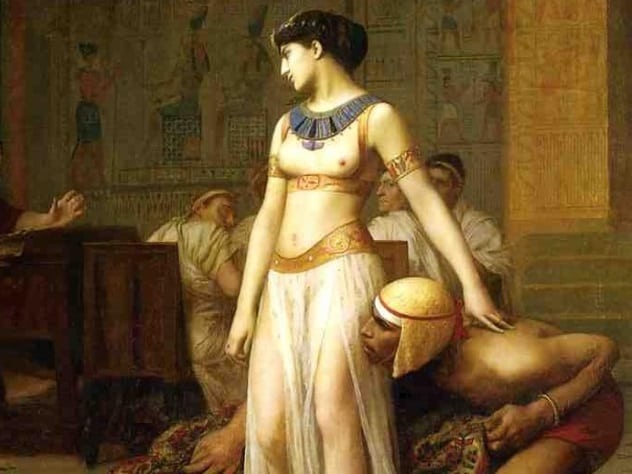
Queen Cleopatra won the hearts of the most powerful men alive. Maybe it was her grace. Maybe it was her charm. Or maybe it was that sweet aroma of dung and insect guts.
Cleopatra, after all, almost certainly followed the usual beauty conventions of her time—and that meant wearing a lipstick made out of mashed-up beetle guts and putting powdered crocodile dung under her eyes.
But Cleopatra didn’t limit herself to a peasant’s beauty regimen. She was a queen, and that meant that she could afford the most luxurious treatment of all: bathing in sour donkey milk. Her servants would milk 700 donkeys each day so that they could fill a tub with their milk. Then, once it had gone bad, Cleopatra would bathe inside.
The theory was that it would reduce wrinkles—and it may actually have worked. Soured lactose turns into lactic acid, which can make the surface layer of skin on a woman’s body peel off, revealing the smoother, blemish-free skin underneath.[2]
That was the real secret to her beauty: burning her flesh off.
8 Nefertiti: Wearing Enough Makeup To Kill You
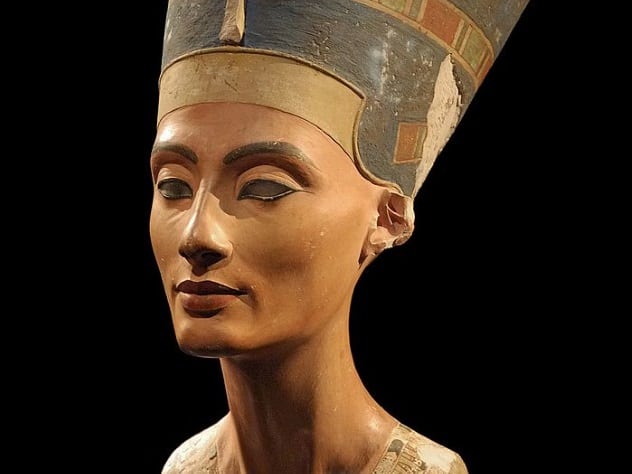
The Egyptian queen Nefertiti’s name meant “the beautiful one has come”—and she lived up to it. She was so beautiful that, in the early 20th century, a statue of her face caused an international sensation. More than 3,000 years after she died, her looks were still front-page news.
And no wonder. She put no small amount of work into looking good.
The queens of Nefertiti’s time would be buried with their makeup,[3] and so, while they didn’t write many of their beauty secrets down, we’ve been able to find their methods left behind in their tombs. While her tomb has never been found, the tombs of her contemporaries give us a pretty good idea of how she did it.
Nefertiti was completely hairless. Her entire body was shaved from head to toe with a razor, including the hair on the top of her head. Instead, she topped her head with a wig and painted her eyes black with something called kohl.
Ancient Egyptian kohl, incidentally, was made out of the dark lead ore galena—which means that Nefertiti was slowly killing herself with lead poisoning every time she put on makeup.
But it’s highly unlikely that the lead killed her. There’s simply no way it could have finished her off before her lipstick. Her lipstick, after all, contained bromine mannite, another toxic substance that it’s generally believed would have poisoned her long before the lead she dabbed around her eyes.
7 Queen Elizabeth I: Coating Your Skin In Lead

Poisoning yourself with lead is no passing fad. It’s been a great look for thousands of years. While Nefertiti may have dabbed a little lead around her eyes, it was nothing compared to Queen Elizabeth I.
During the Elizabethan era, the most popular skin product was something called “Venetian ceruse”—which, quite simply, was a mixture of lead and vinegar that women would put all over their skin to make them look porcelain white.[4]
Nobody used more of it than Queen Elizabeth herself. When she was 29, Elizabeth contracted smallpox and was left with scars all over her skin. She was too humiliated to show her scars in public—and so, instead, she covered every inch of her flesh with the toxic white paint.
Queen Elizabeth used so much of it that she was completely unrecognizable without it. When one man, the Earl of Essex, accidentally peeked a sight of her without her makeup on, he went around joking that she’d hidden a “crooked carcass” underneath that thick veneer of Venetian ceruse.
6 Marie Antoinette: Stewed Pigeon Water
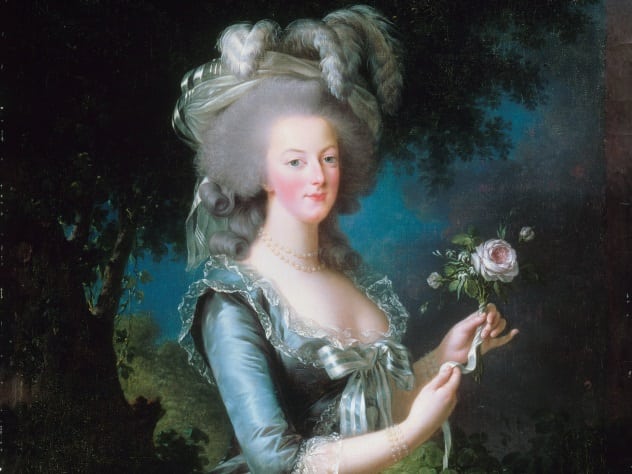
The French queen Marie Antoinette didn’t exactly let herself eat cake. She had a reputation as a world-class beauty, and she was determined to keep it up.
Like Empress Elisabeth, she would go to bed with a face mask, but Antoinette’s—made of cognac, eggs, powdered milk, and lemon—sounds a little bit less like a beauty treatment and a little bit more like the catering menu at a birthday party.
She’d start the morning by washing her face with a facial cleanser made out of pigeons. In those days, that was a selling point: the product came proudly labeled with the mean “Eau Cosmetique de Pigeon” and a little ad promising every bottle had been made with “eight pigeons stewed.”[5]
Then she would get dressed—for the first of three times each day. As queen of France, Marie Antoinette was expected to never wear the same thing twice. And so, each year, she would 120,000 livres on clothes, the equivalent to about $4 million today.
She may even have indulged in the popular French fashion of tracing her veins with a blue pencil. At the time, the women of France wanted to be so thin that they were translucent—so they’d draw the inner workings of their bodies, trying to convince the men that they had transparent skin.
5 Mary, Queen Of Scots: Bathing In Wine

Mary, Queen of Scots, wasn’t a natural beauty. She was born with a nose a little large and a chin a little too sharp—but she was a queen, and she was determined to be beautiful.
To keep her skin as striking as possible, she had her servants fill a bathtub with a white wine.[6] She would wade in it, convinced that the wine was improving her complexion.
It sounds decadent, but it’s actually something people still do today. Today, it’s called vinotherapy, and there are places all around the world where you can experience the Mary, Queen of Scots, treatment for yourself.
It’s hard to say exactly what the queen used, but the modern vinotherapists don’t actually pour drinkable, alcoholic wine. Instead, they use the leftover compost from the winemaking process; the “pips and pulps” of grapes that get left behind. So, no—you can’t get drunk off of it.
4 Empress Zoe Porphyrogenita: Starting Your Own Cosmetics Lab
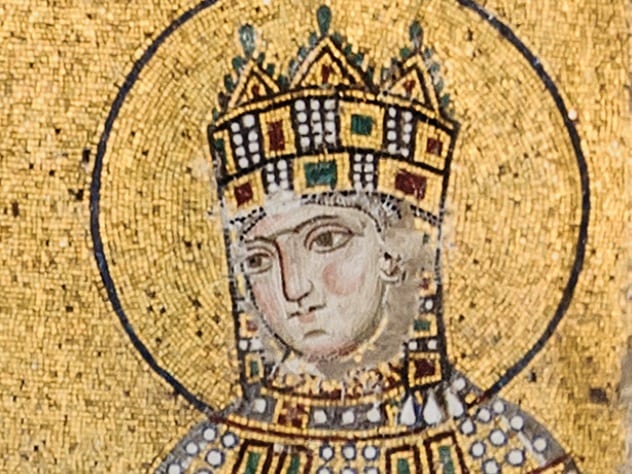
Empress Zoe Porphyrogenita was one of the most beautiful women in the Byzantine Empire. She didn’t just look good when she was young, though. Even when she was well into her sixties, it’s said, she still looked like a 20-year-old.[7]
She certainly worked hard enough for it. After becoming the empress, Zoe Porphyrogenita had an entire laboratory dedicated to making her cosmetics built inside of the imperial palace. It was a real cosmetic factory, every bit as huge and expensive as the ones that supply whole countries. At this one, though, Zoe was the only customer.
It was expensive—but for the empress, blowing a small fortune was just all in a day’s work. It’s said that she was “the sort of woman who could exhaust a sea teaming with gold-dust in one day.”
But it’s also said that “like a well-baked chicken, every part of her was firm and in good condition.” This is definitive proof that it worked, because, clearly, Zoe looked so good that the men who saw her were so smitten that they couldn’t even form a sentence that didn’t make your skin crawl.
3 Lucrezia Borgia: Spending Multiple Days Washing Your Hair
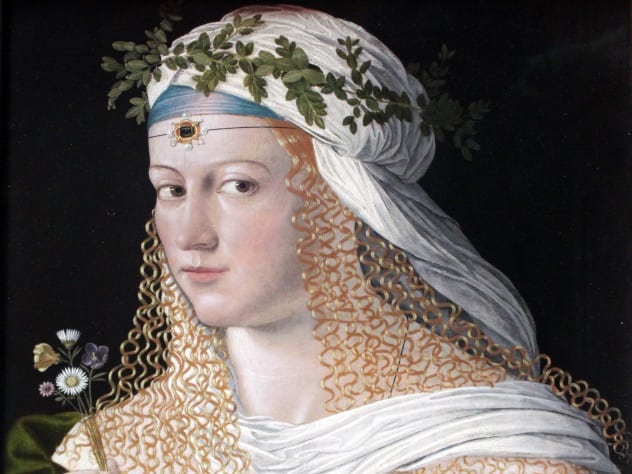
The poet Lord Byron once said that Lucrezia Borgia’s hair was “the prettiest and fairest imaginable.” He wasn’t just trying out a line for a new poem—he was in love, so much so, in fact, that he stole a strand of her hair and kept it by his bed.
It sounds one of those touching love stories that usually end with someone filing a restraining order. Lucrezia, though, probably appreciated it. She deserved a little recognition for the amount of work she put into that hair—because she would spend days washing it.[8]
Lucrezia’s hair was bright and blonde, but that wasn’t nature. Everyone else in her family had dark hair. Lucrezia, though, made sure hers shined like the Sun by rinsing it in lye and lemon juice for hours, then drying it out in the sunlight for the better part of a day.
It took so much time that she repeatedly canceled trips to wash her hair. Multiple letters from Lucrezia’s attendants have survived to to this day. In them, she politely apologizes to people and explains that she will be a few days late because she has to “put her clothes in order and wash her head.”
2 Helen Of Troy: Bathing In Vinegar
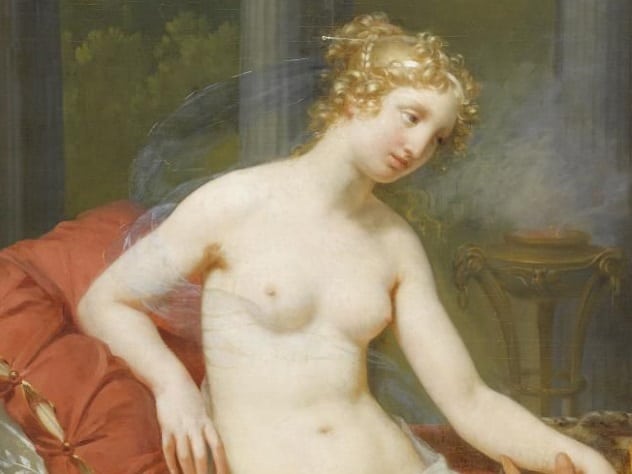
Helen of Troy had the face that launched 1,000 ships. She was a woman so beautiful that thousands of men died for her honor.
Well, either that, or else she was just a figment of an old Greek guy’s imagination. If Homer really did make her up, though, he had a remarkable understanding of women’s cosmetic care. Because packed deep in her legend is a beauty regimen that really works.
Helen of Troy, according to the Iliad, would bathe in vinegar.[9] Every day, her attendants would prepare what, technically speaking, was a bathtub full of acid, and she would just dive right in.
Today, people tend to assume that she used apple cider vinegar or that she diluted it in water, simply because, otherwise, it sounds pretty horrible. After all, that’s something people still do today—bathe in a mixture of apple cider vinegar and water. And it actually works. The vinegar balances the body’s pH levels, which can have a cleansing effect.
But there’s nothing saying Helen of Troy ever added water. She may just have dived right into a bathtub filled to the brim with white vinegar. It would’ve hurt, and she would’ve smelled—but that’s what it takes to look good enough to start a war.
1 Simonetta Vespucci: Arsenic, Leeches, And Human Urine
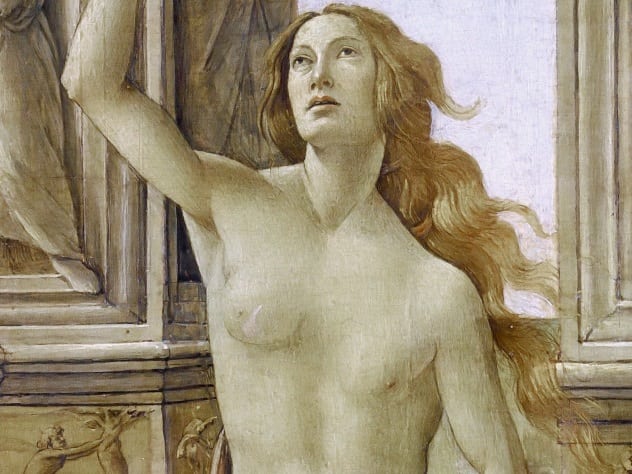
Even if you don’t know her name, you’ve seen Simonetta Vespucci’s face. She was the muse for some of the greatest painters of the Renaissance.[10] She was even chosen to model for the goddess of love herself at the center of the painting The Birth of Venus.
In the Renaissance, everyone wanted to look like her. And so they copied her beauty regimen—leeches, poisons, and all.
To keep their skin pale, white, and beautiful, the women in Vespucci’s time would attach leeches to their ears. The leeches would drain the blood out of their faces, leaving them deathly pale.
Those who didn’t want to go that far, though, could always use a face mask. Renaissance women would mix bread crumbs and egg whites with vinegar and then apply it liberally on their faces—a beauty secret that, conveniently, doubles as a great recipe for fried chicken.
Eyebrow hair, at the time, had to be plucked, or, ideally, burned straight off. Women would remove their hairs with arsenic and rock alum and then sand it all down with gold.
But that was nothing compared to what they’d do to get that long, flowing, golden mane of hair on her head. For Vespucci, it just came naturally, but the poorer women who wanted to copy her found their own way. They bleached their hair in human urine.
Sure, it sounds gross—but every beautiful woman has to do a few things that just aren’t pretty.
Read about more ridiculous beauty regimens on 10 Disgusting Beauty Treatments and 10 Insane Beauty Treatments.








